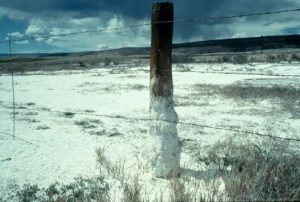10.2 Evaporation from a Water Tablehttps://open.library.okstate.edu/rainorshine/wp-admin/post.php?post=394&action=edit
In locations with a relatively shallow water table, evaporation from the soil can proceed for long periods of time and can dramatically impact the water balance and solute transport. In fact, evaporation from soils with shallow water tables is one of the major factors in the global crisis of soil salinization. When water is transported to the soil surface and evaporates, it leaves behind the salts it carried and those salts accumulate over time (Fig. 10‑2). Salinization is the accumulation of salts in the soil to a level that negatively impacts agricultural production, ecosystem health, and economic welfare [1]. Soil salinization contributed to the downfall of ancient societies in Mesopotamia [2], and it currently affects approximately 397 Mha worldwide or 3.1% of Earth’s land area [3]. Understanding the physics of evaporation from a shallow water table can help us better understand the related process of salinization.

In the simplest approximation, we can treat evaporation from a shallow water table as a steady-state process, meaning that the rate of water movement is assumed to be constant over time and the soil is neither drying nor wetting. All the soil water that evaporates is assumed to be replenished by upward flow from the underlying groundwater table. To estimate the rate of evaporation in this case, we will apply the Buckingham-Darcy Law, Eq. 4-5.
![]()
(Eq. 10-1)
To apply the Buckingham-Darcy Law in this case, we define using Campbell’s hydraulic conductivity function written in terms of pressure potential:
![]()
(Eq. 10-2)
where ψe is the soil’s air-entry potential. We define z as positive down and the water table depth as L, and we assume the pressure potential at the soil surface is -∞, allowing us to integrate Eq. 10-1 to find the maximum possible steady evaporation rate, Emax, for a given soil and water table depth. The resulting equation is:
![]()
(Eq. 10-3)
where N = 2 + 3/b. To see how we arrive at this equation and to see an example of how it can be applied, please watch this video and follow along with paper, pencil, and calculator, working the example.

